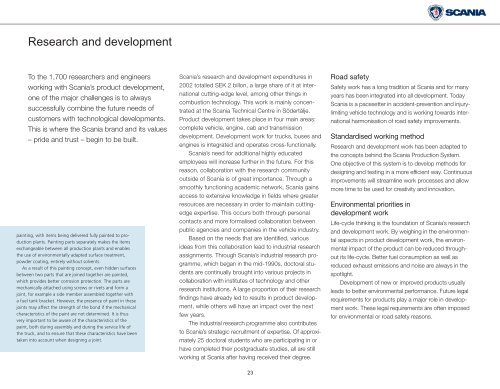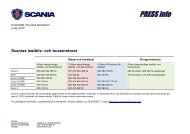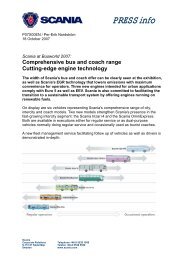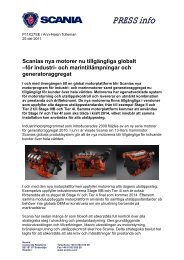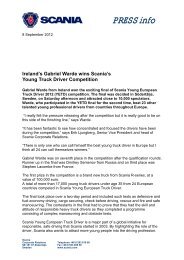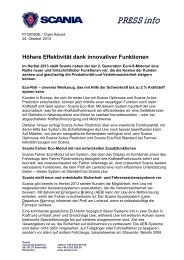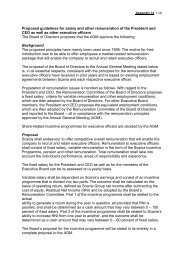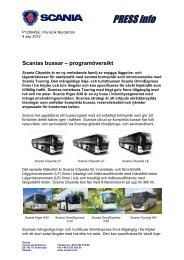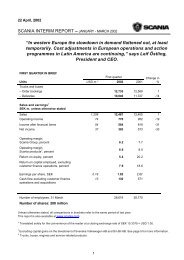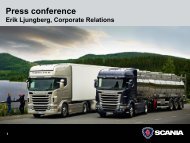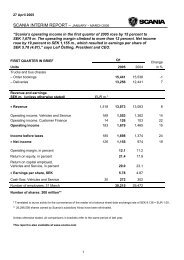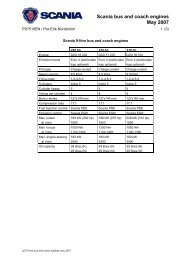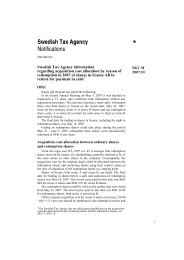Scania annual report 2002
Scania annual report 2002
Scania annual report 2002
You also want an ePaper? Increase the reach of your titles
YUMPU automatically turns print PDFs into web optimized ePapers that Google loves.
Research and development<br />
To the 1,700 researchers and engineers<br />
working with <strong>Scania</strong>’s product development,<br />
one of the major challenges is to always<br />
successfully combine the future needs of<br />
customers with technological developments.<br />
This is where the <strong>Scania</strong> brand and its values<br />
– pride and trust – begin to be built.<br />
painting, with items being delivered fully painted to production<br />
plants. Painting parts separately makes the items<br />
exchangeable between all production plants and enables<br />
the use of environmentally adapted surface treatment,<br />
powder coating, entirely without solvents.<br />
As a result of this painting concept, even hidden surfaces<br />
between two parts that are joined together are painted,<br />
which provides better corrosion protection. The parts are<br />
mechanically attached using screws or rivets and form a<br />
joint, for example a side member assembled together with<br />
a fuel tank bracket. However, the presence of paint in these<br />
joints may affect the strength of the bond if the mechanical<br />
characteristics of the paint are not determined. It is thus<br />
very important to be aware of the characteristics of the<br />
paint, both during assembly and during the service life of<br />
the truck, and to ensure that these characteristics have been<br />
taken into account when designing a joint.<br />
<strong>Scania</strong>’s research and development expenditures in<br />
<strong>2002</strong> totalled SEK 2 billon, a large share of it at international<br />
cutting-edge level, among other things in<br />
combustion technology. This work is mainly concentrated<br />
at the <strong>Scania</strong> Technical Centre in Södertälje.<br />
Product development takes place in four main areas:<br />
complete vehicle, engine, cab and transmission<br />
development. Development work for trucks, buses and<br />
engines is integrated and operates cross-functionally.<br />
<strong>Scania</strong>’s need for additional highly educated<br />
employees will increase further in the future. For this<br />
reason, collaboration with the research community<br />
outside of <strong>Scania</strong> is of great importance. Through a<br />
smoothly functioning academic network, <strong>Scania</strong> gains<br />
access to extensive knowledge in fields where greater<br />
resources are necessary in order to maintain cuttingedge<br />
expertise. This occurs both through personal<br />
contacts and more formalised collaboration between<br />
public agencies and companies in the vehicle industry.<br />
Based on the needs that are identified, various<br />
ideas from this collaboration lead to industrial research<br />
assignments. Through <strong>Scania</strong>’s industrial research programme,<br />
which began in the mid-1990s, doctoral students<br />
are continually brought into various projects in<br />
collaboration with institutes of technology and other<br />
research institutions. A large proportion of their research<br />
findings have already led to results in product development,<br />
while others will have an impact over the next<br />
few years.<br />
The industrial research programme also contributes<br />
to <strong>Scania</strong>’s strategic recruitment of expertise. Of approximately<br />
25 doctoral students who are participating in or<br />
have completed their postgraduate studies, all are still<br />
working at <strong>Scania</strong> after having received their degree.<br />
Road safety<br />
Safety work has a long tradition at <strong>Scania</strong> and for many<br />
years has been integrated into all development. Today<br />
<strong>Scania</strong> is a pacesetter in accident-prevention and injurylimiting<br />
vehicle technology and is working towards international<br />
harmonisation of road safety improvements.<br />
Standardised working method<br />
Research and development work has been adapted to<br />
the concepts behind the <strong>Scania</strong> Production System.<br />
One objective of this system is to develop methods for<br />
designing and testing in a more efficient way. Continuous<br />
improvements will streamline work processes and allow<br />
more time to be used for creativity and innovation.<br />
Environmental priorities in<br />
development work<br />
Life-cycle thinking is the foundation of <strong>Scania</strong>’s research<br />
and development work. By weighing in the environmental<br />
aspects in product development work, the environmental<br />
impact of the product can be reduced throughout<br />
its life-cycle. Better fuel consumption as well as<br />
reduced exhaust emissions and noise are always in the<br />
spotlight.<br />
Development of new or improved products usually<br />
leads to better environmental performance. Future legal<br />
requirements for products play a major role in development<br />
work. These legal requirements are often imposed<br />
for environmental or road safety reasons.<br />
23


